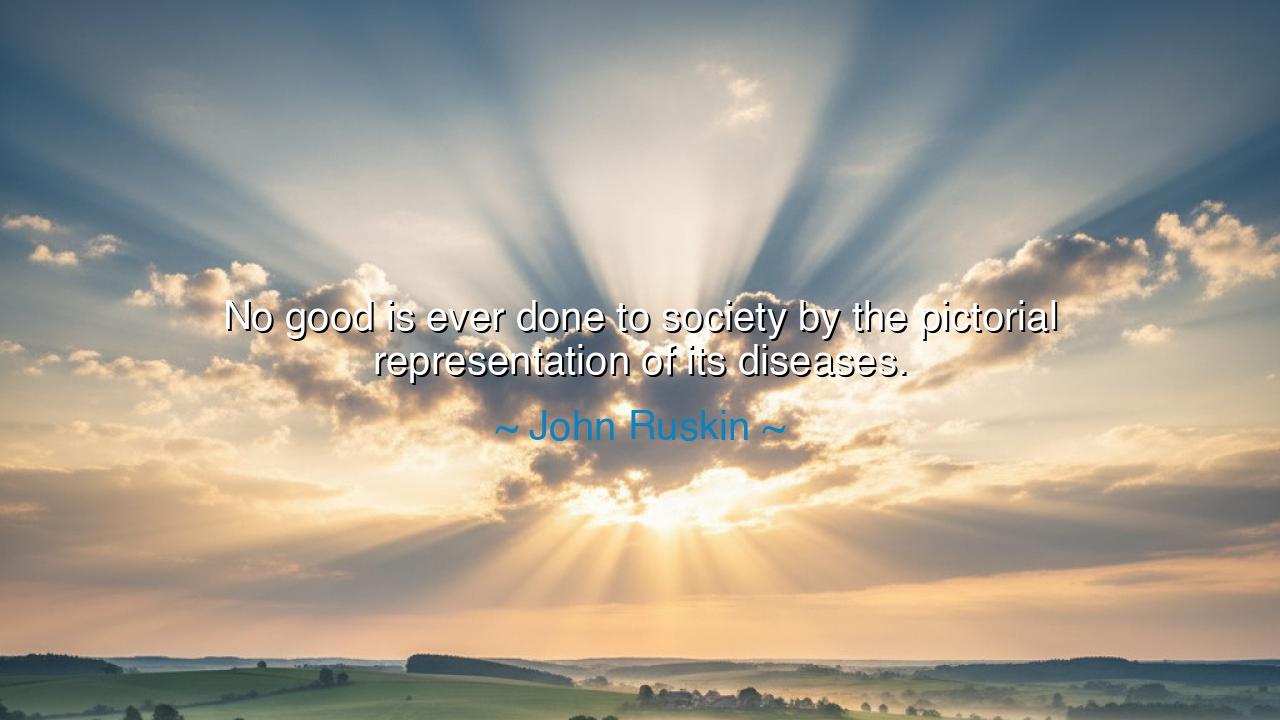
No good is ever done to society by the pictorial representation






No good is ever done to society by the pictorial representation of its diseases, said the wise John Ruskin, a truth that echoes through the ages like a powerful bell tolling in the silence of our hearts. To portray the ills of society, to depict its suffering, its decay, and its despair, is to expose the festering wounds of the body politic. But, how can this portrayal heal? How can it lift the human spirit to higher ground when it merely shows the ugliness, the rot, the sickness of the times? There is no redemption in the glorification of suffering, for such depictions do not offer a path forward, only a mirror reflecting the brokenness of a world that longs for healing.
Consider, if you will, the power of a story, a painting, or a song. These are not mere representations of life; they are meant to elevate us, to carry our souls to heights unseen, to inspire us to act, to change, to transcend the confines of our present existence. But when an artist or a writer chooses to focus solely on the diseases that afflict society, they risk chaining the spirit to despair, rather than uplifting it toward the possibilities of hope, renewal, and transformation. It is as if, in their quest for truth, they forget the greater purpose of art—to guide the heart, to raise the soul, and to nourish the human spirit.
Let us not be deceived by the allure of the dark and the grim, for they do not shape a better future. Victor Hugo, that great writer of the French Revolution, did not simply dwell upon the poverty and suffering of his people, though they were his subjects. He also showed us the power of resilience, of compassion, and the strength to overcome. Les Misérables is not a tale of mere wretchedness—it is the tale of the human spirit’s triumph over adversity. Ruskin’s warning is a call to look beyond the dark corners of society, to not remain in the shadows where disease festers, but to turn towards the light, where hope and renewal reside.
History is filled with examples of art that has not merely captured the ills of society, but has sought to heal them. Consider the Renaissance, a time when great minds and great artists emerged not only to depict the world as it was, but to show us how it could be. Leonardo da Vinci, Michelangelo, and their peers painted not only human suffering but human potential, human grandeur. They painted the ideal, they painted the beautiful, they painted the divine. These were not mere images of brokenness, but visions that transcended it. The beauty they captured in their works lifted the spirit, stirred the heart, and sparked a revolution of thought that shaped the course of history.
But, in contrast, when an artist focuses only on society's diseases, they do little to elevate the human spirit. Take, for example, the era of Victorian England, where poverty and class struggles were often depicted with great detail in art and literature. While these representations raised awareness of the suffering of the poor, they did little to offer solutions or hope. They left the masses drowning in their pain, with no clear way forward. The pictorial representation of disease, in this case, did not heal; it only deepened the wound.
Ruskin teaches us, then, that true art, true expression, must seek not only to reveal but to uplift. To focus on the darkness without showing a path to the light is to perpetuate the cycle of despair. True wisdom lies in transformation, in seeing not just the plague but the possibility of healing, not just the decay but the rebirth. The lesson we must learn is that our minds and hearts, when confronted with suffering, are not meant to remain in it. We are not meant to wallow in the image of disease; we are meant to rise above it, to act, to heal, and to reimagine the world.
So, in your own life, as you face the ills of society, remember this: Do not focus solely on the darkness, for it will blind you to the light. Instead, seek out the ways of healing, the paths of hope. When you encounter the brokenness of the world, do not simply capture it in your art, in your words, or in your thoughts. Instead, work toward a vision of renewal, a vision that lifts the human spirit from despair to hope, from suffering to triumph. In your work, in your life, aim to create, to build, to transform—for this is the true calling of the human spirit.
Remember the lesson of Ruskin: In our art, in our hearts, let us not just depict the disease; let us paint the vision of the cure. Let us be the healers, not the mourners. In this, we will find our greatest calling, our most noble purpose.






AAdministratorAdministrator
Welcome, honored guests. Please leave a comment, we will respond soon